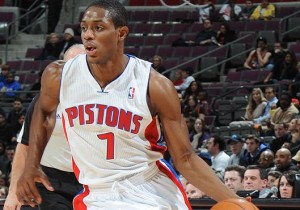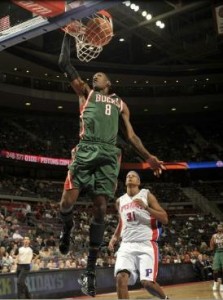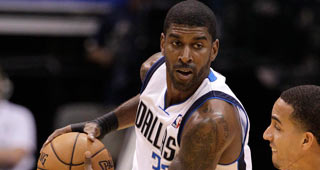 Capping off a mediocrity-defining three-year stretch that saw them finish ninth, ninth and eighth in the East, the Milwaukee Bucks should have entered the summer of 2013 with change as the most obvious mandate.
Capping off a mediocrity-defining three-year stretch that saw them finish ninth, ninth and eighth in the East, the Milwaukee Bucks should have entered the summer of 2013 with change as the most obvious mandate.
As in change everything.
Despite a return to the playoffs and encouraging progress from big men Larry Sanders, Ersan Ilyasova and John Henson, the Bucks had little to show for their efforts last season, as coaching upheaval and a dysfunctional locker room motivated GM John Hammond to take a flamethrower to his roster once again.
Not that any of this was terribly surprising. The trigger-happy backcourt of Monta Ellis and Brandon Jennings predictably proved incapable of lifting Milwaukee beyond the Eastern Conference’s mid-tier, while the lame duck coaching staff of Scott Skiles and later Jim Boylan struggled to manage an ill-fitting roster full of expiring contracts.
In that respect, it’s somewhat surprising that the Bucks didn’t fall apart earlier than they did, although their ability to hang around .500 for most of the season proved a curse once the February trade deadline rolled around.
Loitering at the lower end of the East’s playoff standings emboldened the Bucks to deal promising youngster Tobias Harris for free-agent-to-be J.J. Redick, a move that backfired spectacularly on the court while becoming a lightning rod for criticism of management off it. The Harris debacle was the symbolic last straw for many fans who had begrudgingly gone along with Milwaukee’s annual charge for a low playoff seed, even though the mismatched pairing of Jennings and Ellis had run its course well before that.
Fast forward four long and sometimes confusing months after their blowout first-round loss to Miami, and Hammond and Co. have a reinvented roster better suited for a chance at long-term competitiveness, although the dissonant compete-while-rebuilding philosophy remains largely intact. The arrival of no-nonsense coach Larry Drew from Atlanta likely had a fair bit to do with the summer makeover, as the unsuccessful pursuit of Drew’s protégé Jeff Teague laid the groundwork for Jennings’ eventual sign-and-trade to Detroit for Brandon Knight and Khris Middleton.
All told, 11 of the 15 players Milwaukee fielded last season are gone, with only the young frontcourt of Sanders (24), Ilyasova (26), Henson (22) and Ekpe Udoh (26) returning. Ellis, Jennings, Redick and the perennially underrated Mike Dunleavy are among the departed, with a more budget-friendly mix of youngsters (Knight, Middleton, rookies Giannis Antetokounmpo and Nate Wolters) and veterans (O.J. Mayo, Caron Butler, Zaza Pachulia, Gary Neal, Luke Ridnour, Carlos Delfino) brought in to replace them.
So what are the key themes to keep an eye on for this season’s Bucks?
1. The challenge of the competitive rebuild. Owner Herb Kohl’s annual mandate for a competitive roster has made a true rebuild little more than fantasy for most Bucks fans, as the Bucks continue to attempt the difficult balance between developing young players and retaining cap flexibility without going into a full rebuild.
New assistant GM David Morway saw that model could work during his tenure as GM in Indiana, but it has been a rough three years in Milwaukee since the false promise of the team’s 46-win season in 2010. So while the Bucks were wise (and perhaps lucky) to spend their summer moving on from the Jennings/Ellis era and refocusing on their promising young frontcourt, the decision to spend $16 million on a backup center in Pachulia while also shelling out $24 million for Mayo reasserted the weird and at times contradictory dynamics of their overall plan.
The Bucks are hoping that the veteran additions help keep them respectable on the court in the short term without impinging on long-term cap flexibility. The theory goes that they will also help mentor young players such as Knight, Henson and Antetokounmpo.
The downside is that the Bucks may not have the long-term base of talent to evolve into a top-four team in the East, and puttering around the middle of the playoff pack will make it harder to find a serious talent upgrade via the draft. Either way, the Bucks will try to win as many games as they can this season, even if their relative youth and lack of veteran star power makes that an uphill battle.
Whether all that will help the Bucks eventually escape the black hole of the NBA’s no-man’s land is unclear. With Detroit, Washington, Cleveland and Toronto all expected to climb the East standings, a return to the late lottery seems likely unless the young pieces make major strides. And is all of that preferable to betting more heavily on youngsters, taking your lumps and reloading with a high lottery pick in the loaded 2014 draft? We know where Kohl stands on the matter, and for now that’s all that matters.
2. Sanders in the spotlight. Larry Sanders was the team’s breakout star a season ago, strong-arming the title of Milwaukee’s most indispensable player away from the shot-chucking duo of Ellis and Jennings. His evolution from foul-plagued fan favorite to double-double machine justifiably earned him a $44 million extension over the summer, and along with it increased responsibility as a team leader and de facto face of the franchise.
